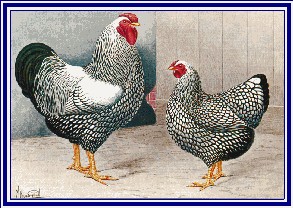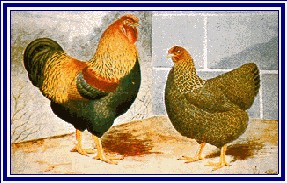Early Breed History
The name Wyandotte derives from a tribe of North American natives who occupied a range in North Eastern America. Although according to the story it was an indirect link, as the ‘Wyandotte’ which the poultry are named after was actually a boat owned by one of the founders of the breed.

The original Wyandottes were silver laced. They were developed from the old English breeds and birds recently brought via Europe from China, including Silver Spangled Hamburgs, Light Brahmas and Buff Cochins (known then as Yellow Chittergongs), . These breeds would certainly account for the size, type and colour of the early Wyandotte. It is also recorded that a large Sebright bantam cock may have been involved in the ancestry of the breed. Other colours were soon developed including gold laced, blacks and the whites which were sports from the silvers.
Wyandottes were originally developed in North America as productive utility birds and the breed was first accepted into the American Breed Standard in 1883. From the start they were famous for their winter laying, with cockerels large and meaty enough to make a good family meal.
The design of the Wyandotte is typically American, they tend to lay white or tinted eggs and yellow skin and legs. The rose comb is practical; they are less vulnerable to heatless due to cold and frostbite than single combs.
The History of Wyandotte Chickens in the UK.
The first Silver Laced Wyandottes were first seen in the UK in1881. In 1896 Wyandottes were imported into England by John Wharton of Hawes, North Yorkshire. He went on to become a notable breeder, judge and exhibitor.
In the early years of the century around 1904/5 there was intense competition to obtain the best birds and prices varied from £35 to the top price for a Cockerel of £165 (which in those days was almost the price of a modest house). One exhibitor in 1904 won at 6 shows and sold the winning bird at each show receiving a total of £550.
In the UK in the early 20th century commercial flocks of White Wyandottes were commonly both for producing eggs and meat. Today, although not so common, large utility white Wyandottes are still available. They are not quite beautiful as their exhibition relatives, one could very easily improve the looks of one’s own flock by using an exhibition cockerel to produce the next generation.

Unlike the Large Fowl the Bantams were created in Britain and although no Bantam Breed Club appears in any list before 1930, bantams were created and in existence long before the First World War. During the period after the end of the War in 1945 until the early 1960’s there was a decline in the number of Large Fowl with an upsurge in the number of Bantams.
The Wyandotte, in many varieties, has retained its productivity and most varieties, even the bantams can be relied on to lay well in winter. Although they are not common in any colour as a breed they are one of the most popular breed in the UK as an exhibition bird and as a very decorative back garden layer
The UK has five Wyandotte clubs to cater for the various varieties. For further explanation of the situation contact the individual clubs via the Poultry Club of Great Britain.

